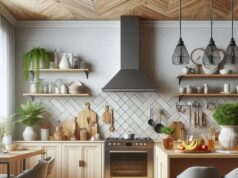
Planning a kitchen renovation but don’t want to deplete savings?
Kitchen renovation costs can be a barrier to modern families who want to update this important gathering place for meals and memories. Traditional kitchen renovation services can be prohibitively expensive for many households.
Here are some facts:
Kitchen remodeling costs have been steadily rising for decades. The average kitchen renovation jumped 34% between last year and this year alone – going from £13,000 in 2024 to £17,500 in 2025. The jump in average spending represents an eye-watering price hike for most families.
Thankfully, there are ways to get the beautiful kitchen you deserve while maintaining a reasonable budget. Clever families are doing it by planning carefully and only spending in strategic places.
Partnering with the right service provider can help ensure success while minimizing cost. Working with a kitchen fitter in my area who understands your budget constraints can transform an otherwise-costly nightmare project into an affordable dream remodel.
The good news is it is possible to achieve a high-end looking kitchen without the expense. It just requires some savvy planning.
What you’ll learn:
- Budget-Smart Planning For Families
- Smartest Spots To Spend (And Save)
- Best DIY Projects To DIY
- Timeline Tips That Save You Money
- Make Every Pound Count With These Renovation Tips
Budget-Smart Planning For Families
Planning is key on a budget
The biggest mistake families make when renovating is jumping in without a plan. This leads to cost overruns, unexpected expenses and stress. A detailed budget from the start helps families avoid overspending.
Plan like a pro by:
Setting a realistic budget. Study other homes in the area to find typical market values for kitchens in your neighborhood. Keep in mind that spending over 15% of your home’s value on a kitchen renovation rarely makes financial sense. Aim for a total budget under £30,000 for a £200,000 home.
Breaking down expenses into line items. Cabinets are typically the largest budget item, at 30-40% of the overall cost. The next major components are appliances, countertops, then labor. Knowing these percentages helps prioritize and spend in the right places.
Budgeting 10-20% extra. Renovations always have unexpected hiccups. This contingency fund prevents stress and budget blow-outs when surprises occur.
Smartest Spots To Spend (And Save)
Certain renovation choices return better value
Investments in different parts of the kitchen return varying levels of value. Minor kitchen remodels return a high 70-80% return on investment which makes them one of the most financially-smart home improvements. Luxury major renovations? A paltry 50-60% ROI.
Focus investment in key areas:
Cabinets are a gamechanger. Cabinets can completely change the look of a kitchen. But not all cabinet options need to be custom-built. Stock or semi-custom cabinets achieve the same wow factor at a fraction of the price. Bonus tip: refacing your existing cabinets can cost thousands less than full replacement.
Countertops are the center of attention. Quartz and granite countertops are very expensive. But some engineered materials can mimic the look for less. Laminate is a long-time underrated option and today’s laminates can be hard to spot.
Appliances make a difference. No need to opt for the top-shelf luxury brands. Mid-range models with high customer ratings work just as well. Prioritize energy efficiency to save on utility bills down the road.
Hold back on these expenses:
Custom storage systems are rarely worth it. Outlets for pots, pans, spices and other tools are easily sourced from big box home improvement stores. You don’t need to build in something unique for these items. Exotic and expensive materials look nice but provide minimal value. Don’t overdo it.
Structural changes can be overkill. Moving walls or cabinets will cost a fortune. Often you can achieve the same effect by repurposing and rearranging as-is elements. Layouts can be improved without drastic measures.
Best DIY Projects To DIY
DIY can save labor costs
Families who tackle certain renovation projects themselves can save thousands on labor costs. But it’s important to know which projects are DIY-friendly and which require professional skills.
DIY projects for beginners:
Paint is the easiest, fastest refresh. Painting cabinets and walls is a totally different kitchen. Buy a quality primer and take time with prep-work for the best results.
A backsplash adds big style. Peel-and-stick tiles make installation a breeze. Traditional tiles are also DIY-friendly with patience and online tutorials.
Hardware upgrades are quick wins. New cabinet handles and knobs are a very small investment that give an instant update.
Jobs that should be left to the pros:
Plumbing & electrical are no-no’s. Mistakes in either area lead to super-expensive repairs. Gas lines are also very high risk. Leave this to your kitchen fitter for safety and code-compliance.
Timeline Tips That Save You Money
Timing is part of the budgeting strategy
When you renovate affects both cost and quality of kitchen renovation services. Savvy families will schedule their projects with timing in mind to optimize savings.
Renovating during the off-season is cheaper. Contractors book up and charge a premium during the busy spring and summer seasons. Fall and winter work often has better pricing and faster turn-around.
A longer timeline saves money. Rushing through a project to finish means paying top-dollar for speedy decisions. Planning 2-3 months ahead allows you to find great deals on materials & appliances.
Phasing a renovation spreads out costs. It’s not necessary to complete all work at once. Break the kitchen project into multiple phases over months or even years. This makes large projects more affordable.
Make Every Pound Count With These Renovation Tips
Spending should add value
The point of renovating a kitchen isn’t just to make it look pretty. The point is to create a better space that adds value to your family’s home and lifestyle. Make sure your renovation is smart by following these tips.
Prioritize functionality above all:
Better layouts lead to more usable kitchens. A few small workflow improvements can make cooking easier. Adding counter space or improving the work triangle between sink, stove, and fridge creates noticeable impact.
Organization = practicality. Storage solutions like pull-out drawers, corner cabinets and pantry organizers don’t cost much but make a kitchen much more functional.
Lighting is the ultimate transformation. Install under-cabinet lights, pendant fixtures and recessed lighting to brighten dark corners and create mood. LEDs are a great energy-saving option.
Appeal to a future buyer:
Neutral tones have more appeal. What you like isn’t always what’s in demand when you sell. Stick to neutral whites, greys and natural wood shades that go with any style.
Invest in durable materials. Trying to save money on key areas leads to the need for replacements sooner. Choose long-lasting materials that will hold up for years.
Energy-efficiency is a bonus. Energy star rated appliances, LED lighting and water-saving fixtures are both good for the environment and add resale value.








